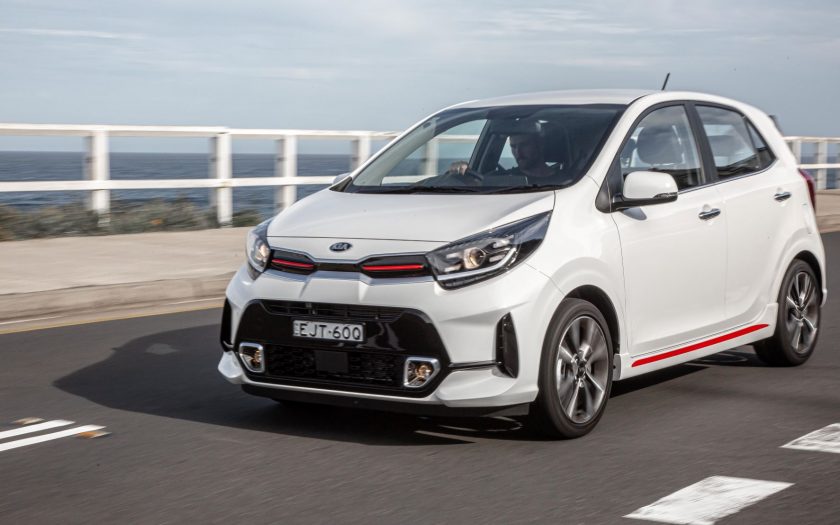Chris Riley tests the 2023 Kia Picanto GT Turbo with pricing, specs, ride and handling, safety, verdict and everything the over-50 driver needs to know.
Summary: It’s very small, and the price has risen substantially since it was first released, but there’s a lot to like about the little Kia Picanto GT. Unless you want an auto.
Kia Picanto GT Turbo hatchback
Pricing: $20,790 (plus on road costs)
Options: Premium paint $520
Warranty: Seven-years, unlimited km
Safety: 4-star ANCAP (tested 2017)
Build location: South Korea
Engine: 1.0-litre turbo intercooled 3-cylinder petrol
Power: 74kW at 4500rpm
Torque: 172Nm at 4000rpm
Transmission: 5-speed manual, front-wheel drive
Body: 3595mm (long); 1595mm (wide); 1485mm (high)
Weight: 995kg
Towing capacity: not stated
Wheels: 16-inch alloy
Tyres: 195/45 R16
Ground clearance: 141mm
Turning circle: 9.4m
Fuel tank capacity: 35 litres
Official consumption: 4.8/100km (91 RON fuel)
Consumption on test: 5.8/100 (540km)
seniordriver consumption on test: 5.2L/100km (351km)
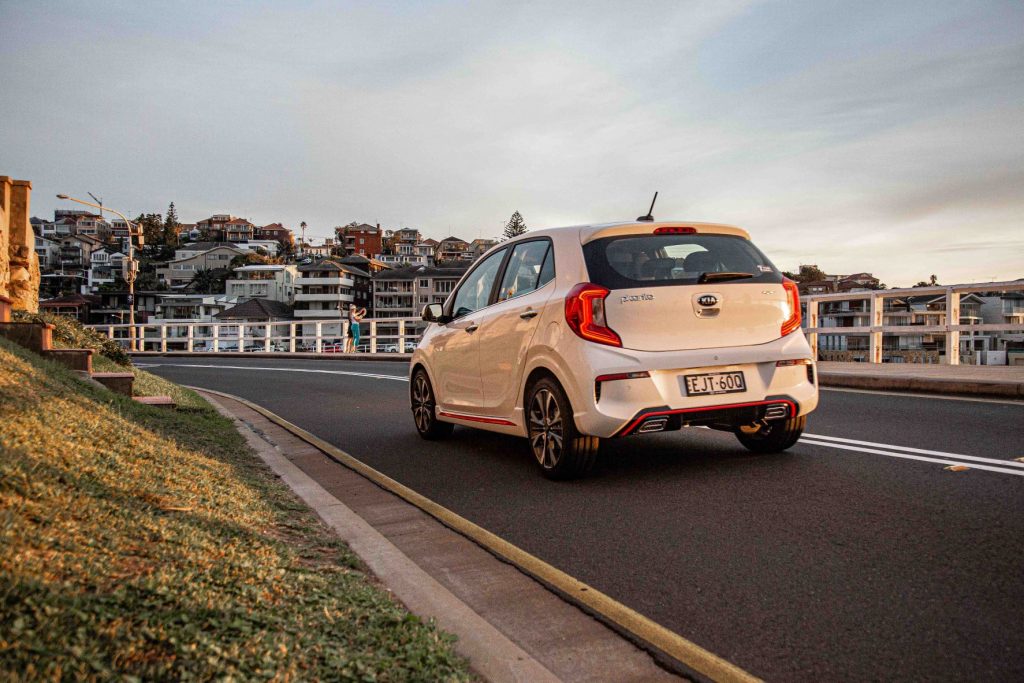
[review]
Kia’s baby Picanto hatch was last upgraded in June, 2020.
It saw a refreshed, more distinctive appearance and greater differentiation for higher grade models.
The so-called ‘tiger-nose’ grille remains sleek and sporty but with a sharper and more assertive appearance.
Below the grille is a restyled lower air intake, magnifying the aggressive look of the front end while the rear boasts a new bumper design with dual exhaust tips and a wider, more aggressive posture.
New design 16-inch alloy wheels were also added.
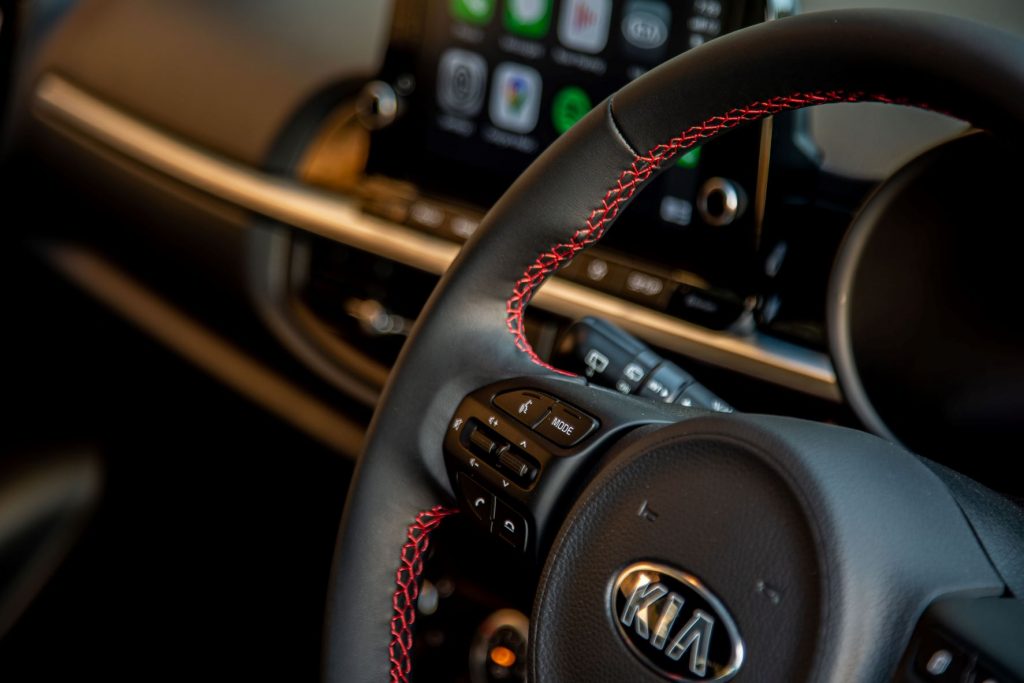
What’s it cost?
Picanto GT costs significantly more than it did when it was launched.
Back then in 2019, the GT was $17,990 driveaway and at that price why wouldn’t you buy one?
Fast forward almost four years and the price has climbed to $20,490, another $2500 more for the same car – and that’s before on-road costs. Quite frankly some of the gloss has come off.
On top of this, we’re still trying to work out what exactly the buyer profile is for the Picanto GT.
It’s unlikely to be women because the GT is not available with an automatic, while young blokes in our experience tend to give pocket hatches a wide berth in favour of something more masculine.
For those who must have an auto, there’s the $17,440 look-alike GT-Line model, but it has a less powerful 1.2-litre engine.
That leaves older buyers, most probably commuters, who want something with a bit of spark that will keep them out of the slow lane – and that, importantly, doesn’t use much fuel.
The Picanto GT ticks both these boxes, with its tiny, zippy turbocharged powerplant.
Comfort and convenience extend to manual air, leather look seats with red accents, cruise control, auto lights (but not wipers), LED daytime running lights, reverse parking sensors, steering wheel-mounted audio controls, driver seat height adjustment and power windows front and rear with auto-up on driver’s window.
Infotainment consists of an 8.0-inch touchscreen, six-speaker audio, Bluetooth connectivity, AM/FM radio, plus Apple CarPlay and Android Auto (both wireless), together with 12-volt and USB charge ports in front of the console.
You can connect two phones at once, but alas, it misses out on DAB+ digital radio and wireless charging, as well as satellite navigation.
Not big fans of Android Auto but thought we’d give it another go.
Took several attempts to connect, dropped out 10km from destination and the phone was almost flat by the time we arrived.
Back to the cable. Sheez!
And don’t forget you need an internet connection.
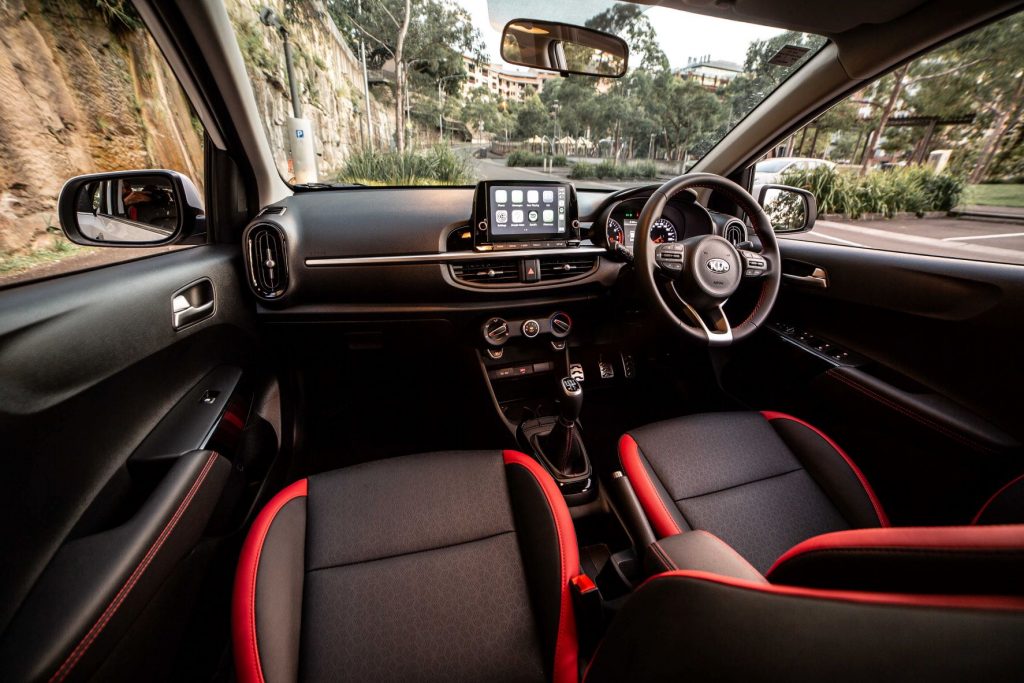
Tested in 2017, Picanto gets four out of five stars for safety.
The previous model got five. It appears to have been marked down because it lacks adaptive cruise control.
Safety encompasses six airbags, reversing camera, forward collision warning and an auto emergency braking (AEB) system which operates at city and interurban speeds.
It’s also fitted with vehicle stability management, brake-based torque vectoring, ABS, ESC and Hill Assist Control.
The GT can be identified by contrast body accents, twin exhausts, sports body kit and a GT badge.
It is available in Clear White with the premium colours Titanium Silver, Aurora Black and Signal Red, a $520 option.
Service intervals are 12 months/10,000km and like all Kias, it comes with a 7-Year Warranty, 7-Year Fixed Price Servicing and 7-Year Roadside Assist.
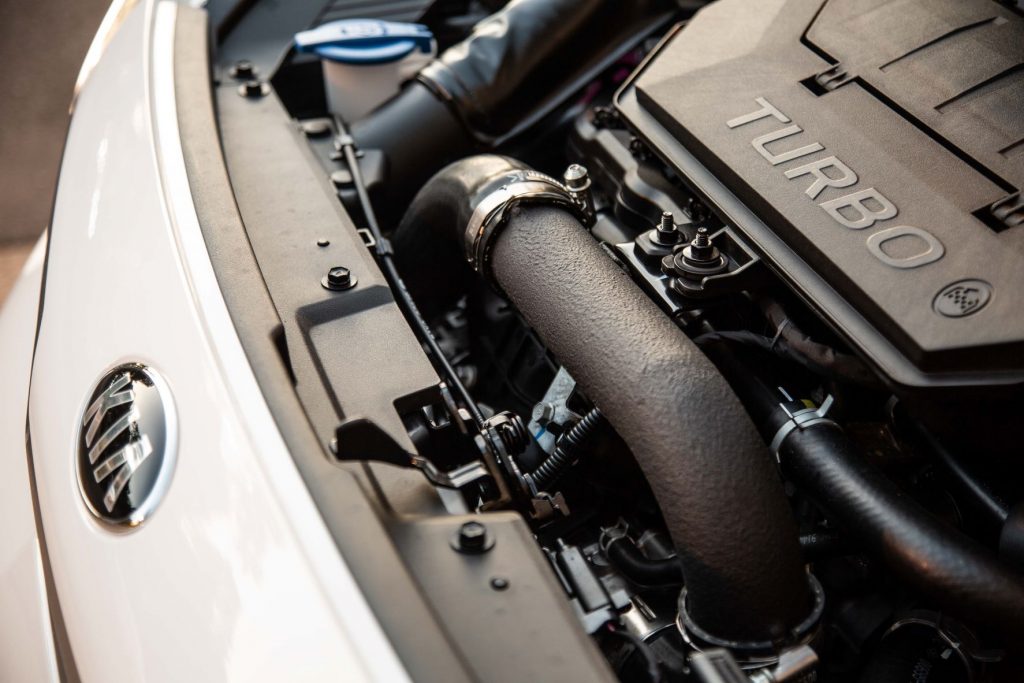
What’s it go like?
Five seatbelts are optimistic.
The chances of fitting three adults across the back are Buckley’s and none, exacerbated by limited legroom and a lack of rear air outlets.
Space in the front isn’t bad, with a manual-adjust driver’s seat, driver’s footrest, and steering wheel that is rake and reach adjustable – but you’re likely to bump elbows with your passenger.
While there’s plenty of storage in the centre console and even a tiny lidded console box, trying to find room for two full-sized drink bottles is a challenge.
It’s key start and instrumentation comes in the form of two traditional analogue gauges that flank a central 4.2-inch information panel where speed can be displayed digitally.
Red highlights, contrast stitching and alloy pedals combine to give the cabin a sporty ambience.
But the star attraction of this model is the tiny turbocharged engine.
At 998cc, with three cylinders, turbocharging and direct injection, it produces 74kW of power and 171Nm of torque, the latter from 1500 to 4000 rpm.
It’s paired with a five-speed manual transmission. There is no automatic, so don’t bother asking.
Apart from some throttle flare the change is easy and fairly forgiving to use. The trick is not to hurry gear changes.
Slot home the gear, then take a breath before letting out the clutch pedal and don’t lift off too soon.
You’ll find it works a lot better that way. Trying to rush the process will result in missed gears and a surge when you let out the clutch, drawing enquiring looks from your co-pilot.
The car cruises easily and has no trouble with hills, but you need to keep the revs up to maintain turbo boost – without boost you haven’t got much of anything.
It’s a single-scroll turbocharger paired with an electric wastegate motor.
This improves turbocharger performance while scavenging clean air for the engine to re-use for combustion.
At the same time, it allows the wastegate to open to improve the flow of spent exhaust gases.
It is an innovative system which allows higher low-end torque, more immediate response at any throttle opening and improved fuel economy at high engine loads.
With a 35-litre tank, fuel consumption is a claimed 5.2L/100km and it takes a standard 91 unleaded.
To go with the turbo power, the Picanto GT’s suspension has benefited from some fine tuning by Kia’s local ride and handling team.
With more aggressive shock absorbers and a stiffer spring rate, the team was able to achieve greater body control with better feedback and improved ride comfort.
Changes to the steering mapping deliver quicker response and enhanced stability under load.
Lower profile 195/45 R16 rubber brings more grip and predictability when pushing towards the limit (as if).
The spare by the way is a space (and weight) saver.
Ride quality can be harsh at times, but curiously not unpleasant. Perhaps this could wear thin over time.
Pushing hard, the car remains surprisingly composed and handles corners in a controlled fashion, with some wheel hop at times.
Note, too, GT scores rear disc brakes, something of a rarity in this segment.
Those fancy-looking tailpipes are not connected to the exhaust system by the way.
The rear diffuser hides a rather normal muffler with two small downturned outlets.
Rated at 5.2L/100km, we were getting 5.8L/100km after 540km.
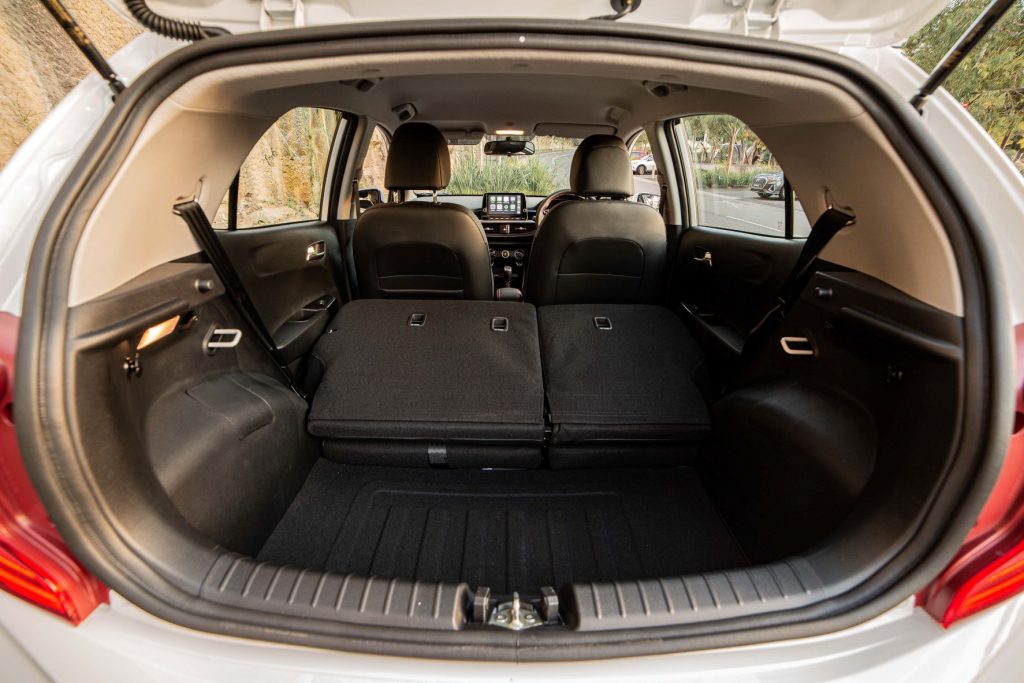
What we like
- Sporty
- Cheeky looks
- Manual change
- Auto emergency braking
What we don’t like
- Throttle flare
- Small fuel tank
- No navigation
- No digital radio
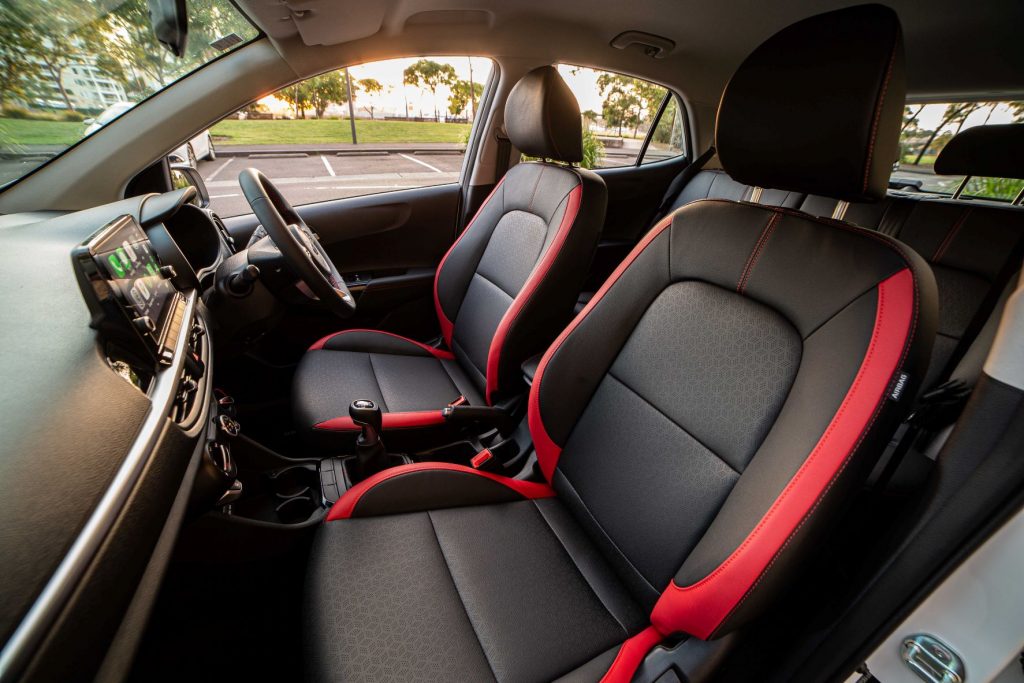
What over-50s driver need to know
Picanto GT is fun and obviously fills a need for some drivers.
Manual transmissions, even in sporty models, are becoming few and far between these days.
Even for $2500 more the price is still attractive, but let’s not get carried away because a Polo GTI it ain’t.
But if you still fancy a manual and are looking for something cheap and fun to drive, the GT could be the one.
It’s a practical little runabout that is easy to get in and out of, doesn’t come with a barrage of confusing gadgets and uses very little fuel. Gotta like that.
Too bad it misses out on navigation and digital radio. There was a time when Kia said navigation would always be standard in its cars. How quickly we forget.
seniordriver comments
When we drove the Kia Picanto GT, we decided it was a lot of fun, but a little less than macho. And that will be a problem for the smallest Kia. The absence of an automatic option will put a lot of people off, while the buyers who will gravitate towards a sporty manual will want something with a bit more street cred.
It’s a sign of the times that the days of sub-$20k cars have almost disappeared. Even the Picanto price has crept up, leaving just the 1.2S and 1.2 GT-Line below the magic $20,000 price point. There’s only one other Kia under $20k and that’s the base model Rio five-door hatch that squeaks in at $19,690 (although on road costs will push it above the $20,000 mark). And as for other brands, only MG’s MG3 five-door hatch makes the cut, at $18,990 (driveaway) for the 1.5-litre Core and $19,490 if you specify sat nav and the Suzuki Baleno five-door hatch 1.4 GT is also on offer, priced at $18,490 (plus on road costs).
As usual, the real price of the Picanto is $21,310 because any colour other than white will cost you an additional $520. We keep calling this out because we think it’s deceptive, even though most car companies do the same thing.
Fortunately, most over-50s drivers learnt in manual-geared cars, but we’ve all become a bit spoiled by the ease of driving autos, especially in and around our cities.
And one final consideration: you can’t fight physics. If you’re driving something small and light like a Picanto and you’re hit by something like a two-tonne SUV, you’re inevitably going to come off second best.
